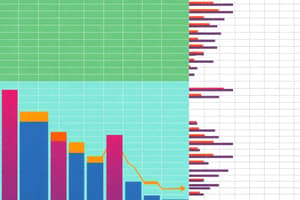Podcast
Questions and Answers
What percentage of females aged 60 and above participated in the survey?
What percentage of females aged 60 and above participated in the survey?
- 25%
- 63% (correct)
- 29%
- 40%
Which age group had the highest percentage of females participating in the study?
Which age group had the highest percentage of females participating in the study?
- 18-29
- 30-44
- 45-59
- 60+ (correct)
In which age category did males show the lowest participation percentage?
In which age category did males show the lowest participation percentage?
- 18-29
- 45-59
- 30-44
- 60+ (correct)
What is the overall participation percentage for all ages for males?
What is the overall participation percentage for all ages for males?
How does the average percentage of females compare to males in the 45-59 age group?
How does the average percentage of females compare to males in the 45-59 age group?
What is the grand total percentage of participants across all ages?
What is the grand total percentage of participants across all ages?
Why are pie charts preferred over bar graphs for certain data presentations?
Why are pie charts preferred over bar graphs for certain data presentations?
What type of data is primarily represented using pie charts?
What type of data is primarily represented using pie charts?
What percentage of land use is dedicated to fruit trees in the UAE?
What percentage of land use is dedicated to fruit trees in the UAE?
Which category of land use has the smallest area in the UAE according to the presented data?
Which category of land use has the smallest area in the UAE according to the presented data?
What combined percentage of land use do vegetables and field crops occupy?
What combined percentage of land use do vegetables and field crops occupy?
What is the implication of having 30% of the land being fallow?
What is the implication of having 30% of the land being fallow?
What aspect could improve the effectiveness of the pie chart?
What aspect could improve the effectiveness of the pie chart?
In terms of land use diversity, what does the pie chart reflect?
In terms of land use diversity, what does the pie chart reflect?
Which type of variable is not represented in the pie chart showing land use?
Which type of variable is not represented in the pie chart showing land use?
What year does the presented data on land use pertain to?
What year does the presented data on land use pertain to?
What is the total frequency of repair costs recorded in the dataset?
What is the total frequency of repair costs recorded in the dataset?
Which class has the highest frequency for repair costs?
Which class has the highest frequency for repair costs?
What is the relative frequency for the class '90 but less than 100'?
What is the relative frequency for the class '90 but less than 100'?
What percentage of repair costs falls into the '60 but less than 70' category?
What percentage of repair costs falls into the '60 but less than 70' category?
Based on the class boundaries, how many repair costs are recorded for '100 but less than 110'?
Based on the class boundaries, how many repair costs are recorded for '100 but less than 110'?
What is the class width derived from the data provided?
What is the class width derived from the data provided?
What percentage of repair costs fall under the class '50 but less than 60'?
What percentage of repair costs fall under the class '50 but less than 60'?
Which of the following statements is correct regarding the repair cost data?
Which of the following statements is correct regarding the repair cost data?
What is the purpose of 'eyeballing' the data in the analysis phase?
What is the purpose of 'eyeballing' the data in the analysis phase?
Which type of variable is referred to as qualitative?
Which type of variable is referred to as qualitative?
What must you identify to choose the best visual representation for your data?
What must you identify to choose the best visual representation for your data?
What is a key advantage of using a radar chart?
What is a key advantage of using a radar chart?
Which of the following is NOT a method for organizing qualitative data?
Which of the following is NOT a method for organizing qualitative data?
Which graphical display is often used for showing trends over time?
Which graphical display is often used for showing trends over time?
Which of the following scenarios is NOT suitable for using a radar chart?
Which of the following scenarios is NOT suitable for using a radar chart?
What is the main benefit of using infographics in data presentation?
What is the main benefit of using infographics in data presentation?
When using a radar chart, what is a key aspect to ensure accurate interpretation?
When using a radar chart, what is a key aspect to ensure accurate interpretation?
Which of the following variables would be most appropriate to measure on a radar chart for employee performance?
Which of the following variables would be most appropriate to measure on a radar chart for employee performance?
What distinguishes continuous variables from discrete variables?
What distinguishes continuous variables from discrete variables?
What is a potential downside of using a radar plot?
What is a potential downside of using a radar plot?
Which of the following best defines nominal variables?
Which of the following best defines nominal variables?
In what situation might bar plots or line charts be preferred over radar charts?
In what situation might bar plots or line charts be preferred over radar charts?
In a radar chart, how are different values across each axis represented?
In a radar chart, how are different values across each axis represented?
What does a radar chart enable when comparing performances of students?
What does a radar chart enable when comparing performances of students?
Flashcards are hidden until you start studying
Study Notes
Presenting Data: Visualizations
- Visual exploration of data can guide deeper analysis.
- Using visualizations help to understand and reason about data presented as tables, graphs, and infographics.
- It is important to be able to read, interpret, and reason about data visualizations.
- Various engaging and interactive techniques are used in media and online platforms to present data.
- Excel and other supporting packages can be used to create accurate and informative tables, charts, and diagrams.
- Choose the best visual representation for the data.
- The main types of variables are qualitative and quantitative.
- Qualitative variables can be nominal or ordinal; quantitative variables are continuous or discrete.
- Pie charts are useful for showing how a whole is divided into its component parts.
- Pie charts are ideal for showing percentages or shares of a total, such as revenue share, population breakdown, or budget allocations.
- Radar charts compare multiple datasets or individuals across a set of variables.
- Radar charts compare items measured on a similar scale, such as percentages or ratings.
- Radar charts visualize the overall profile or pattern of data points rather than specific values.
- Radar charts identify outliers or extreme values.
- Radar charts present data in a visually appealing and easy-to-understand format.
Case Study 3: What the Language You Tweet Says About Your Occupation
- Many aspects of a person's life are deeply connected to their job.
Studying That Suits You
Use AI to generate personalized quizzes and flashcards to suit your learning preferences.



